Before we show you Nicholas’s solution, let’s remind ourselves of the challenge he was posed.
This summer is the inaugural Continental Cup. Each of the six FIFA governing bodies will be competing against each other.
— Total Football Analysis (@TotalAnalysis) June 15, 2020
Before I dive into my Tactics Wars solution, let’s remind ourselves the challenge… This summer is the inaugural Continental Cup. Each of the six FIFA governing bodies will be competing against each other.
While you were hoping to manage team UEFA or CONMEBOL, you ended drawing a chance to manage team CAF. This means you can pick players from any African nation to represent your team. Your first match of the tournament is against team CONCACAF.
After scouting some of their friendly matches, you know them to be an attack-minded team who are possession heavy and will look to play out from the back.
They play with aggressive centre-backs and move into a 2-3-5 in possession pushing the WB’s up high to support with Hirving Lozano and Christian Pulisic dropping next to Raul Jimenez. Michael Bradley steps into the midfield during the attack, attempting to help dictate the tempo of the play.
Lineups
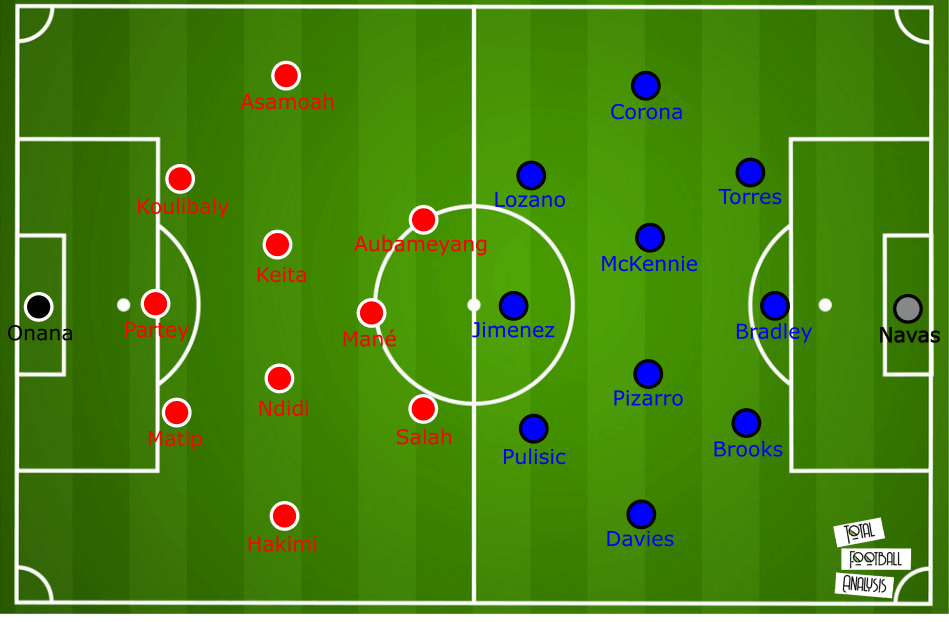
CONCACAF (1-3-4-3): Keylor Navas, Jesus Corona, Roman Torres, Michael Bradley, John Brooks, Alphonso Davies, Weston McKennie, Rodolpho Pizarro, Hirving Lozano, Raul Jimenez, Christian Pulisic.
As mentioned above, CONCACAF is an aggressive team in possession adopting a 2-3-5 formation with Bradley stepping out of the backline which could create overloads centrally and facilitate their ball circulation. Additionally, I expect they will attempt to use the pace of Bayern Munich wing-back Davies down the left flank whenever possible and the wing-back battle will be key in this match. With the aerial threat of target man, Jimenez who is clinical in the box, preventing crossing opportunities from wide areas and the half-space will be key. The danger of Lozano and Chelsea’s Pulisic in between the lines where they notoriously cause problems will be something that we must cater for by preventing the use of the half-space in the final third.
CAF (1-3-4-1-2): André Onana, Kalidou Koulibaly, Jöel Matip, Thomas Partey, Kwadwo Asamoah, Naby Keïta, Wilfred Ndidi, Achraf Hakimi, Saidio Mané, Mohamed Salah, Pierre-Emerick Aubameyang.
Due to the number of quality players available, my selection is largely predicated on who I feel will fit the roles within our 1-3-4-1-2 system best. When compared to our opponent’s lineup in this tactical analysis, I feel we generally have a qualitative advantage across most playing positions. As a result, I have selected a similar formation to CONCACAF with the intention to match up with them across the pitch and fight fire with fire.
On this premise, we have gone for two pacey wing-backs with Borussia Dortmunds’ Hakimi, in particular, is one of few players that may be able to match counterpart Davies’ speed. Having a goalkeeper of Onana’s quality with his feet will allow us to get creative. The defensive qualities of Koulibaly, Matip, Partey and if necessary Ndidi will allow our wing-backs to advance and give us freedom offensively. In the attacking phase, we will encourage the front three to be as fluid as possible and to exploit spaces in behind the wing-back in the half-space. To counteract CONCACAF’s intention of having Bradley stepping out into midfield, Mane will be positioned in the number 10 role out of possession and will naturally match up with him. Additionally, we will leave two attackers in Salah and Aubameyang upfront intentionally.
Building the attack
If CONCACAF uses a high press, the positioning below should cause them numerous problems. The positioning of Salah, Aubameyang and Mane is key in order to provide height, pin the centre-backs back, and create space centrally as highlighted in the graphic below. This is complemented by Ndidi and Keita who vacate the central area and position themselves in the half-space. This forces McKennie and Pizarro to decide whether to follow them into these areas or remain central and screen their back three, leaving Keita and Ndidi free. If they decide to follow Keita and Ndidi this will spread them in midfield and open up passing lanes for our backline to play directly into our front three, who have the option to remain high, or exploit the vacant central area giving us a numerical advantage in central midfield as Mane looks to do below.
We will take advantage of the ‘+1 rule’ in our defensive third when playing out from the back. If CONCACAF decides to press high we will be in a position of numerical superiority (4 vs 3). We will lean on Onana as a free man who will provide a passing lane at the bottom of a diamond, with Koulibaly and Matip positioned on either side, and Partey forming the top of the diamond behind CONCACAF’s first line of pressure. The wing-backs will be high and wide to create space in central areas providing support to the centre-backs if needed.
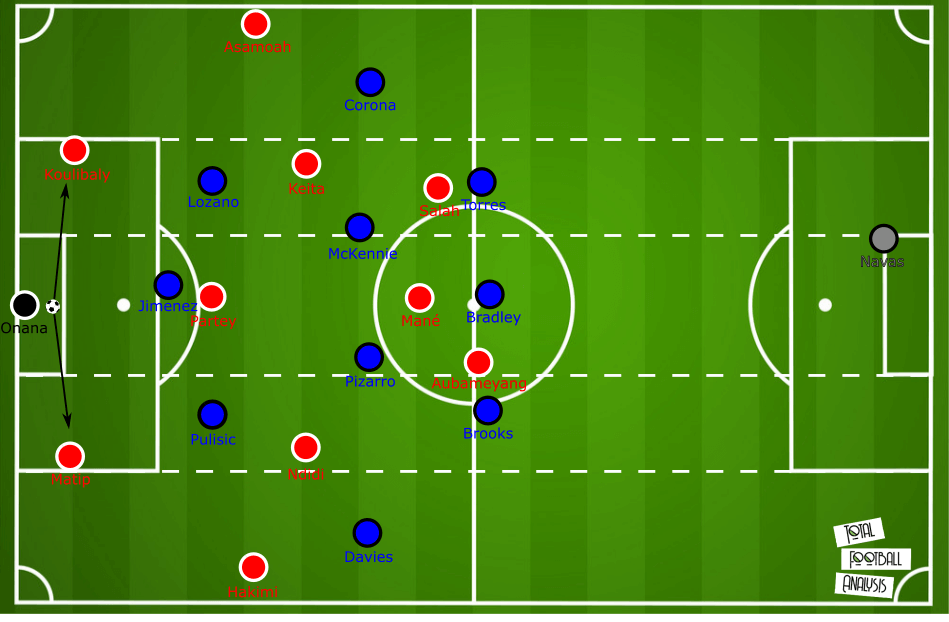
Creating a diamond by using Partey beyond the line of pressure is critical. We will assume Onana starts by playing to left centre-back Koulibaly. In this scenario, he will most likely be pressed by Lozano. If Lozano curves his run from inside to out, to force Koulibaly to play down the line, we have the option to play to our wing-back Asamoah. From here Asamoah would be supported by Partey and Keita centrally, in addition to a run from Salah into the left channel. If Lozano curved his run from outside to in, Koulibaly would have two passing options in Partey and Onana. Also, if Jimenez attempted to stop the ball being played to Onana, Partey would be left free and a pass to him would break the CONCACAF press. If Jimenez pressed with Partey in mind, he will most likely have Partey in his cover shadow, and Onana would be free to play to the opposite centre-back so we can circulate the ball until we find an opening. Finally, if a central midfield player stepped up to mark Partey and create a 4 vs 4, huge gaps would be left in either half-space and a more direct pass through could be a favourable option for us.
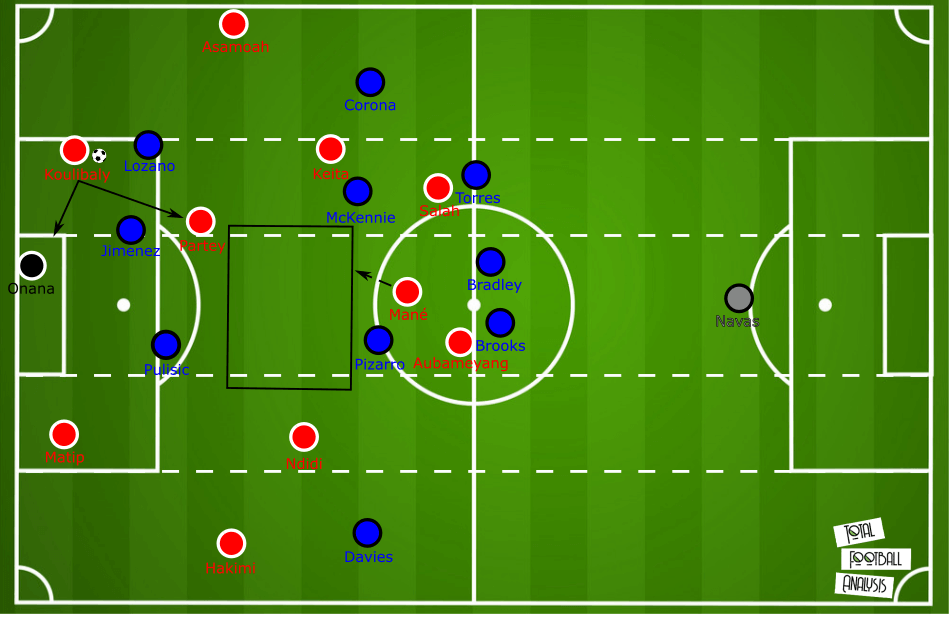
Creating central overloads in possession
As we know CONCACAF intends to control possession and dictate the tempo, we will aim to do this by maintaining possession ourselves, limiting their opportunities to get a foothold in the game. To facilitate this we will lean on Onana’s distribution and encourage him to take up a centre-back position, once again pushing Partey forward into midfield to create a diamond with Koulibaly and Matip on either side once again, see below. A diagonal pass to a wing-back from Onana may be an option however we will refrain from taking up this option where possible, instead, favouring a pass into Partey on either side of Jimenez in between the lines. The purpose of this will be to eliminate CONCACAF’s front three and give us a 3 vs 2 central overload in midfield.
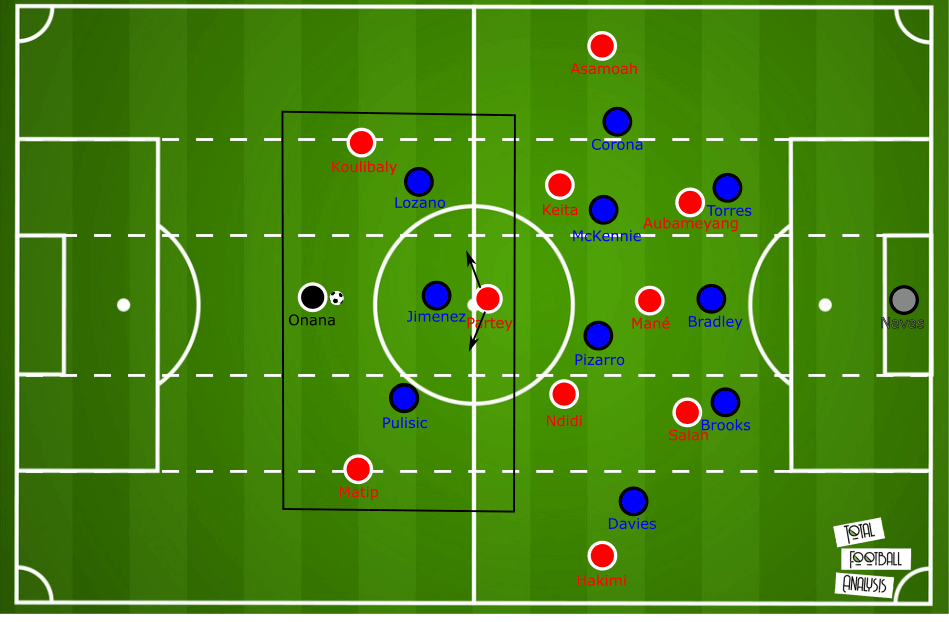
Below we can see the opportunities this tactic will create. Numerical superiority in midfield puts Partey in an advantageous 3 vs 2 situation where we also have the opportunity to create another central diamond between Partey, Keita, Ndidi and Mane. Partey’s task in possession here will be to draw out McKennie or Pizarro and find the free man in between the lines.
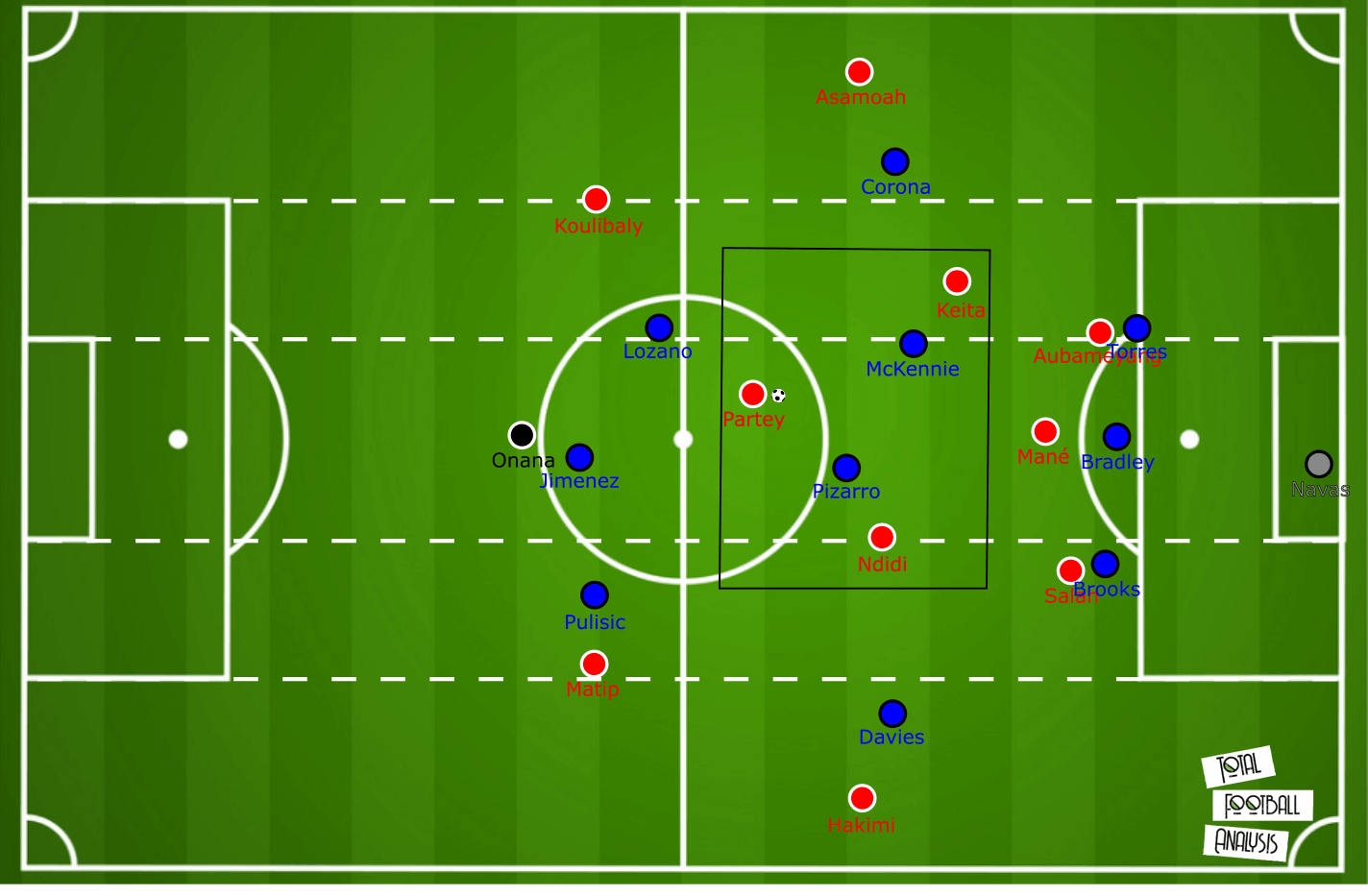
Creating the attack: Using rotations to penetrate
In our system we will use rotations to disrupt the CONCACAF defensive structure, creating space and positional superiority for us when trying to make final third entries. Below are two examples that we will use to achieve this.
Rotation 1
If the ball has travelled from left to right as in the situation in the picture below, as the ball travels across the backline from Koulibaly to Partey, Ndidi will drop into Matip’s position as a right-sided centre-back. Simultaneously Matip will move high and wide into an advanced wing-back position, and Hakimi with tuck inside into the half-space whilst Salah remains high to pin-back Brooks.
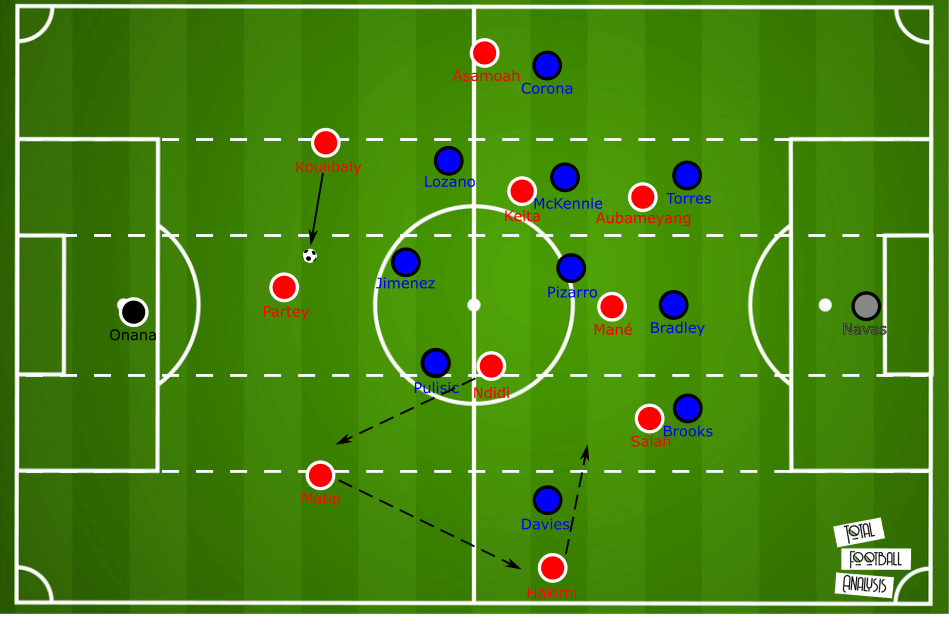
As pictured below, Hakimi’s position in the half-space means he becomes a dangerous passing option who allows us to retain numerical superiority (3 vs 2) in the central zone which Ndidi vacated. Additionally, this puts the opposition wing-back, Davies, in a difficult situation. If he wants to avoid us penetrating centrally and exploiting the central overload he may choose to tuck in. In doing so, this leaves the right flank open and Ndidi can play a progressive pass down the flank in behind Davies which may force Brooks to come across and stretch the opposition backline who are already matched up 3 vs 3. Alternatively, Matip could be missed out and a direct pass into the same space behind Davies could be played to Salah also, both decisions could allow us to isolate Brooks in a 2 vs 1 situation on the right flank.
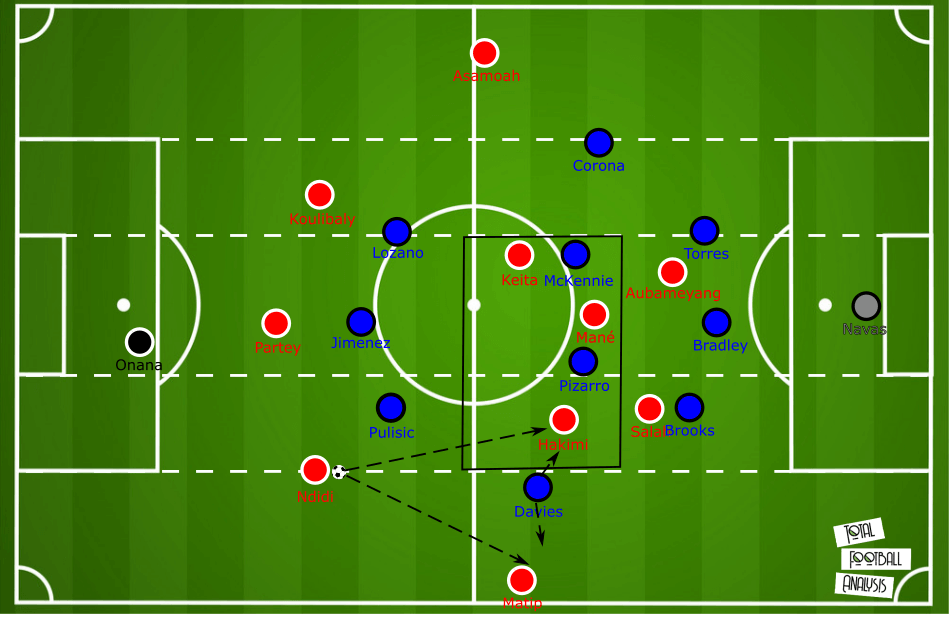
Rotation 2
I expect CONCACAF to try to prevent penetrating vertical passes through the centre and allow passes into the full-back or wing-backs as play is still in front of them and it does not disrupt their defensive structure. We will try to take advantage of this by opening up space centrally. The rotation will start as the ball is played into our wing-back from our left or right-sided centre-back. In this case, left-sided centre-back Koulibaly passes to Asamoah on the flank, see below.
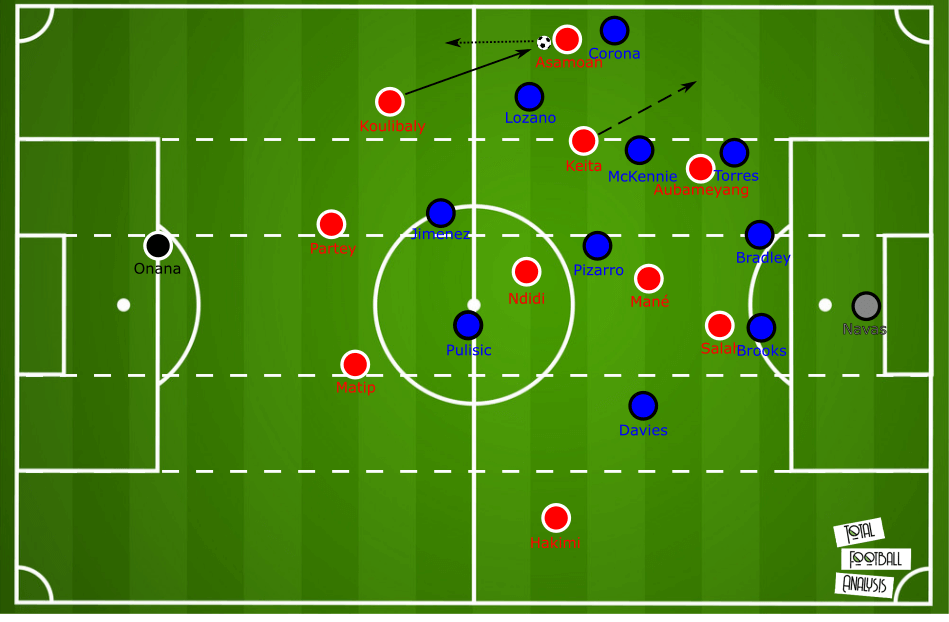
As the ball reaches Asamoah, Keita will make a forward run into the wide-area in behind the CONCACAF wing-back Corona. Upon receiving the ball Asamoah will dribble the ball down the line towards Koulibaly. Keita’s run will likely pull McKennie away from the centre-midfield area or at least force him to drop deeper.
Below, we can see that this rotation the potential to create space centrally. Asamoah will look to play the ball back to Koulibaly, breaking the vertical line between Koulibaly and Lozano. Koulibaly can now step into central midfield and exploit the space created by Keita’s initial run, see below.
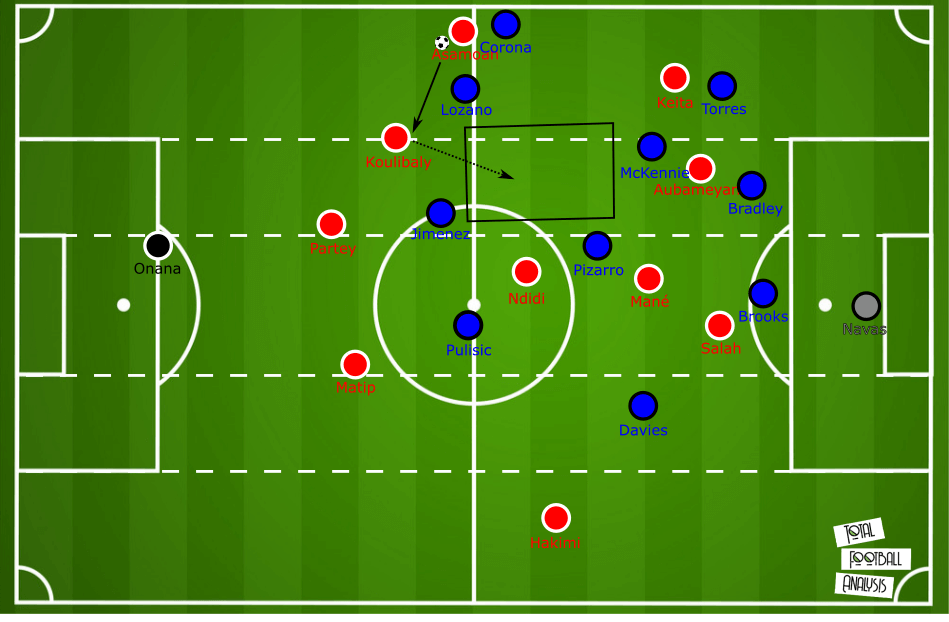
Finishing the attack – Combinations in the final third
Where possible we will look to play vertical passes through opposition lines. To capitalize on our final third entries, a forward pass into the front three will be a trigger for our midfield line to support them by either positioning themselves close by giving them a passing option instantly upon receiving (for the striker to set the ball back for example) or run beyond the attacker receiving the ball. Below is an example of this occurring as Ndidi plays a vertical pass between Pizarro and McKennie into Aubameyang’s feet. This is Keita, Hakmi, and Mane’s trigger to make a forward run.
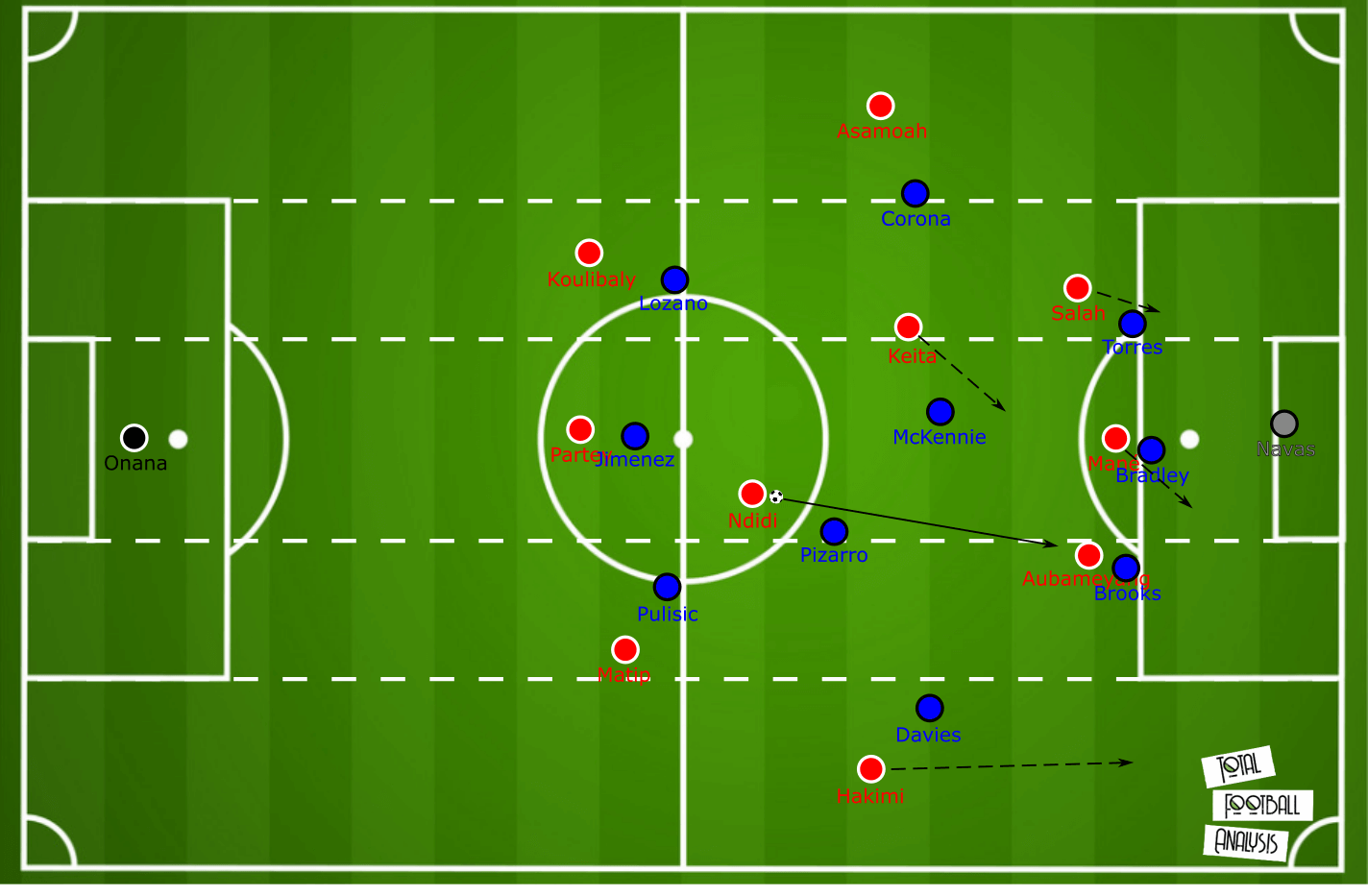
As the ball is travelling, Keita, Hakimi, and Mane all recognize this and make runs accordingly providing options both in behind (Mane and Hakimi), and in front to combine (Keita). This will be extremely effective if we can combine within zone 14 often in between the opponents’ midfield and defensive line.
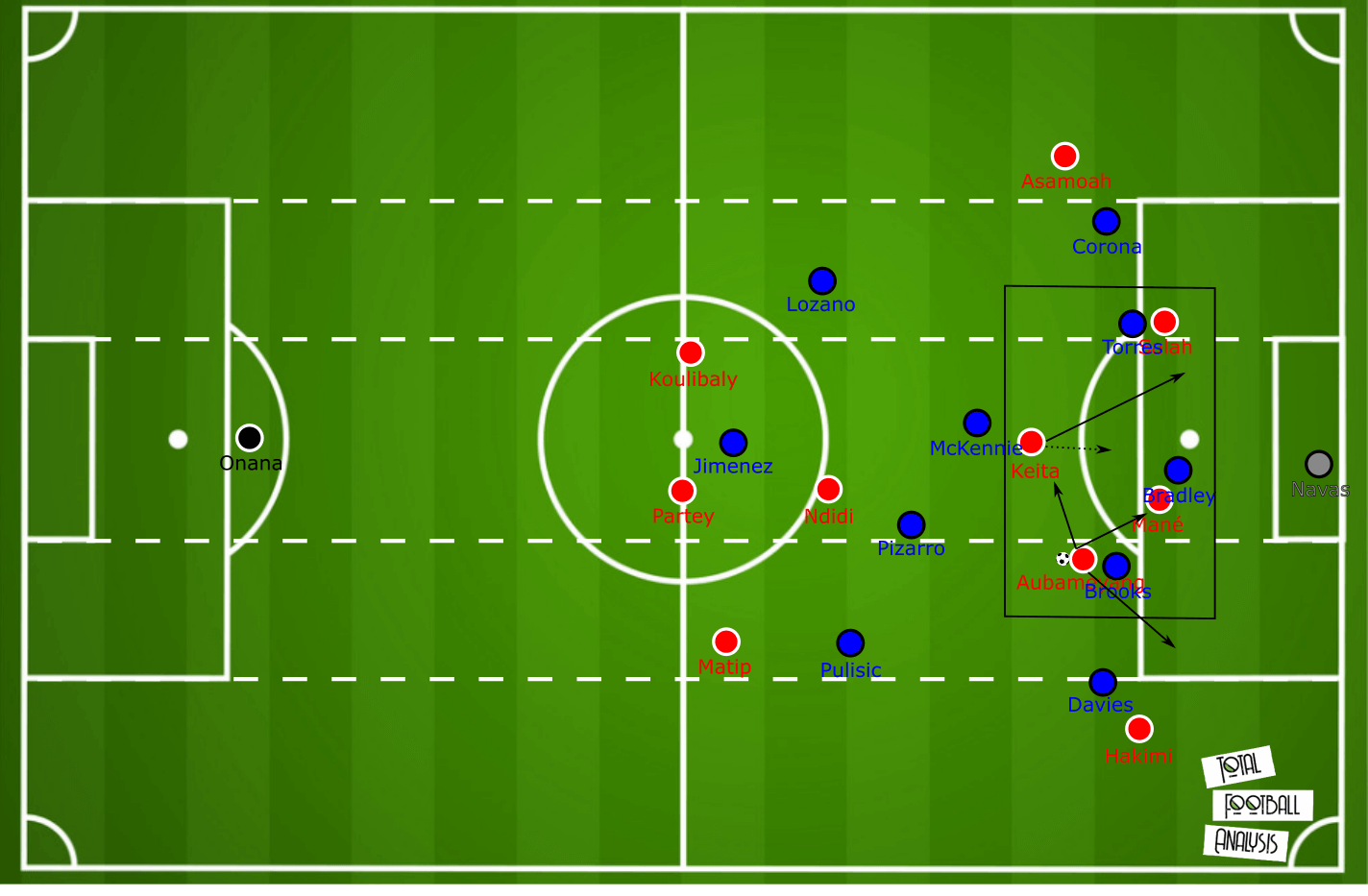
Defensive transition – Counterpressing to swarm the opposition
As CONCACAF are a team who like to control possession, we will attempt to disrupt this by winning the ball back as quickly as possible through an aggressive counterpress to nullify any opposition counter-attacks. This will be man-orientated attempting to shut off immediate passing options and regain possession as high up the pitch as possible. Stopping the opponent in attacking transition will be paramount to our team’s success as we illustrated previously, in possession we commit a significant number of players to our attacks. The following pictures will illustrate what this may look like.
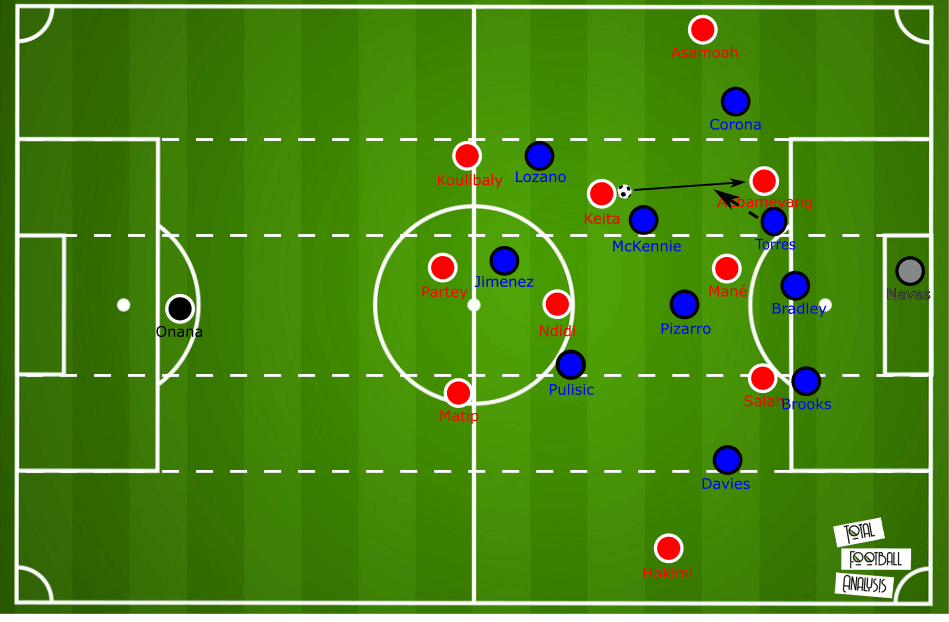
Keita looks to find Aubmeyang with a vertical through pass. Right-sided centre-back Torres recognizes this and steps across to successfully intercept the ball.
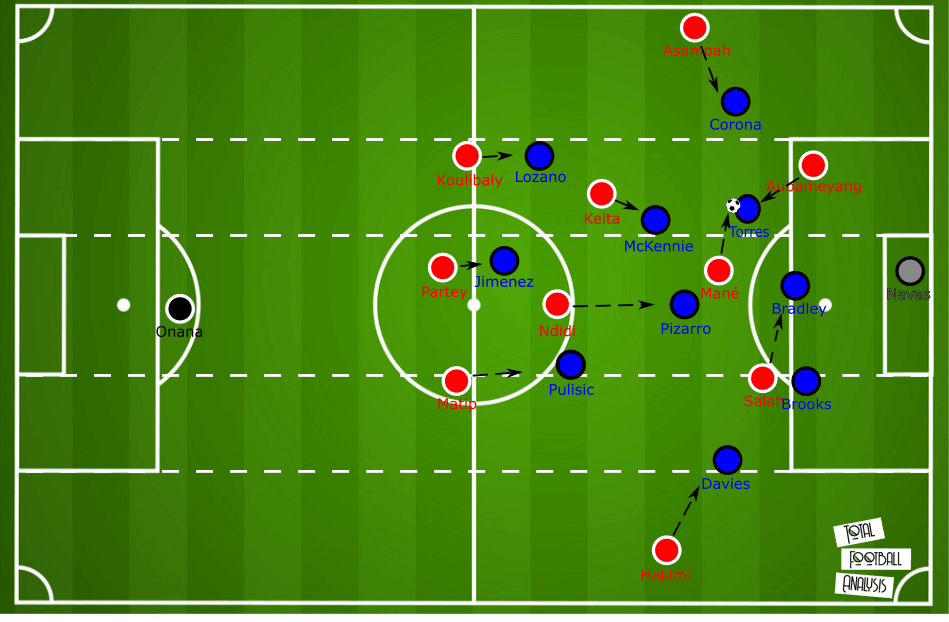
As soon as this occurs, an aggressive counterpress will be activated as each CAF player will lock on to their nearest opponent and remove all immediate passing options, particularly forwards, which could relieve Torres from our pressure.
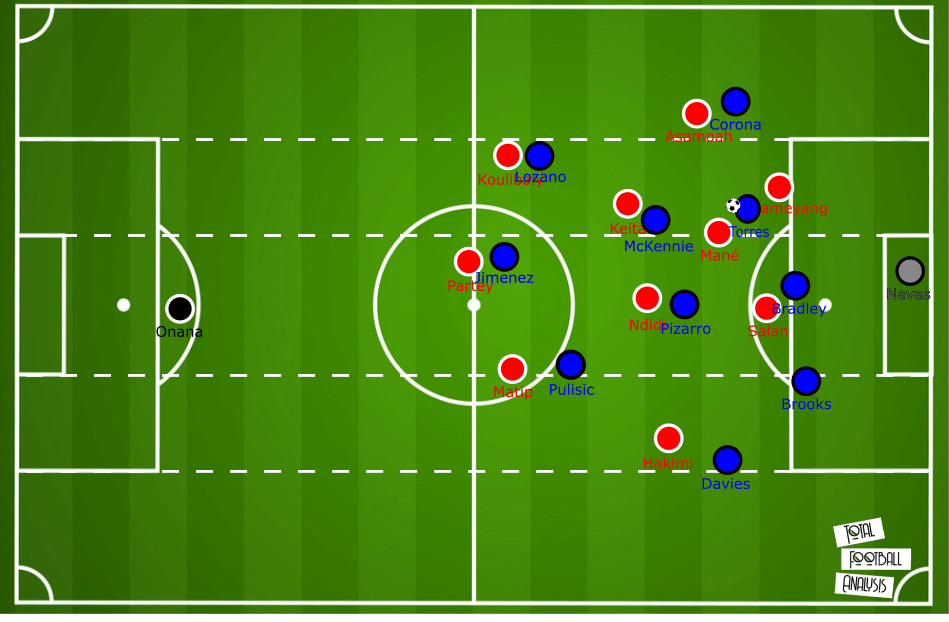
As pictured above, we can see the ‘swarming effect’ we will attempt to create around the ball to stifle CONCACAF in possession and win the ball back as quickly as possible.
Out of possession – High press
CONCACAF likes to play out from the back so for us to have success in this game we must stop them from creating attacks this way and playing through our defensive structure. To do this we will aim to reduce spaces available to them in central areas and set pressing traps for us to capitalize on in wide areas.
As a team, we will prioritize remaining compact centrally by having Salah and Aubameyang start slightly narrower than the left and right centre-backs with Mane waiting just behind them. This will be done to avoid CONCACAF using Bradley as a single pivot when playing out from the back. As a result, passes to the left and right centre-back will be the only players the opposition can play to away from direct pressure, see below.
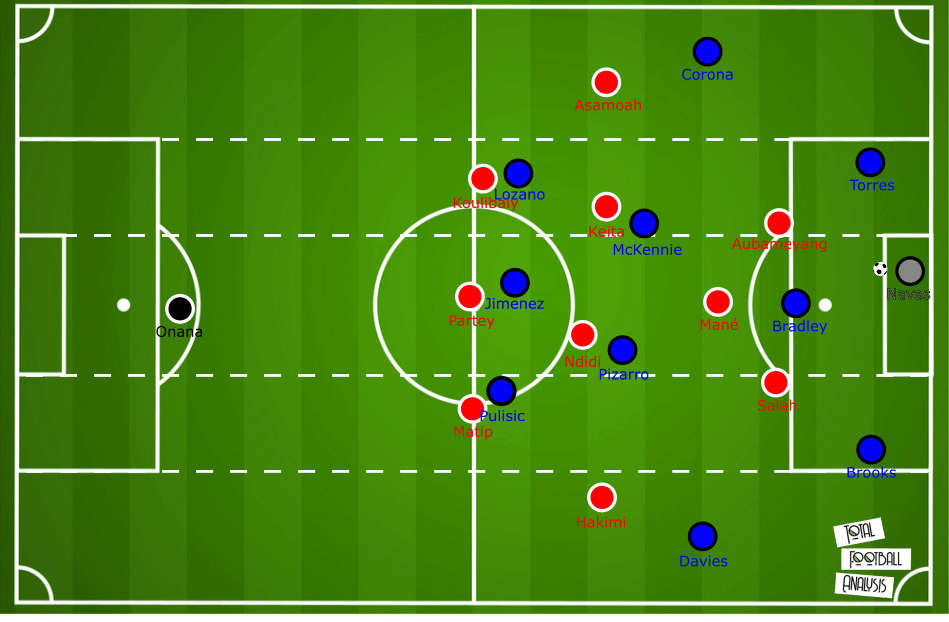
As Navas plays out to one side, the seven outfield players behind our front three will engage the closest player to them and match CONCACAF’s front three and midfield four. Only when Torres has turned away from Navas with the ball (notice ball position below), Aubameyang will look to curve his run from inside to out forcing Torres out further. Simultaneously Mane will drop in between Navas and Bradley in a ‘half and half’ position while Salah tucks inside slightly.
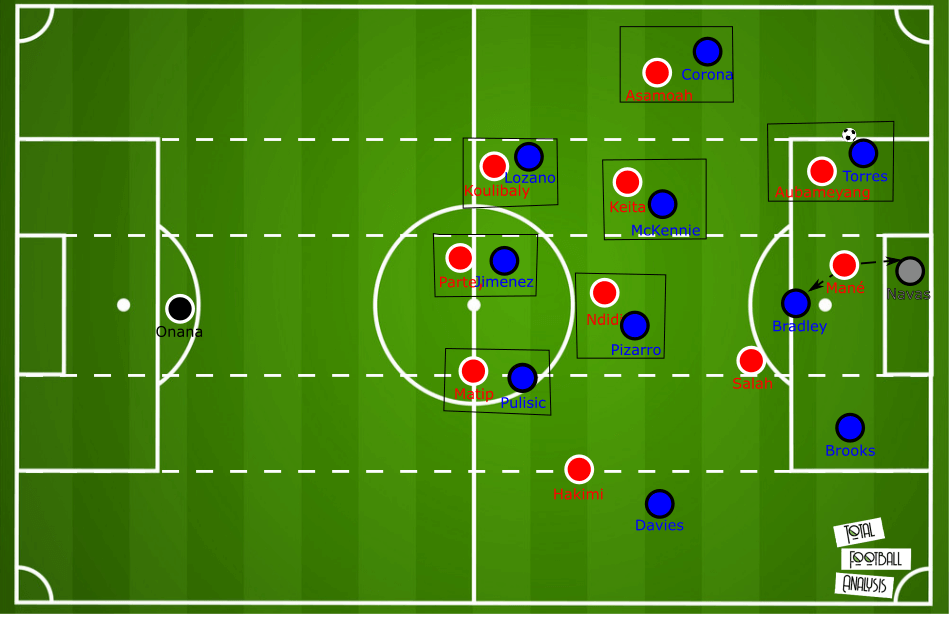
Using a pressing trap such as this (above) will allow us to dictate where CONCACAF have possession of the ball and allow us to disrupt their build-up phase. Pressing aggressively once Torres has turned away from Navas will mean it is not favourable for him to turn back as it will give Aubameyang time to tackle him. Additionally, with the added strain Mane’s position puts on CONCACAF build-up, we will decrease the opportunities for them to play their way out of pressure by using Navas or Bradley. Mane must be cautious and make sure a pass does not get to Bradley as this will break our press and release CONCACAF. Similarly, a man orientated press will be initiated if the opposition has established possession, and we will use a pass back or turn towards their own goal as a trigger.
CONCACAF 2-3-5 attacking threat
Although the tactics that we will try to implement will aim to prevent CONCACAF from having sustained periods of possession, we know that they can be extremely aggressive when given the opportunity and adopt a 2-3-5 formation in possession where possible. This is something we must be prepared for and an adaptation of the 3-4-1-2 formation we have adopted will facilitate this. Essentially, we will create a 5-3-2 structure to counteract CONCACAF’s attacking formation whilst posing a dangerous threat of our own in attacking transition when the ball is won.
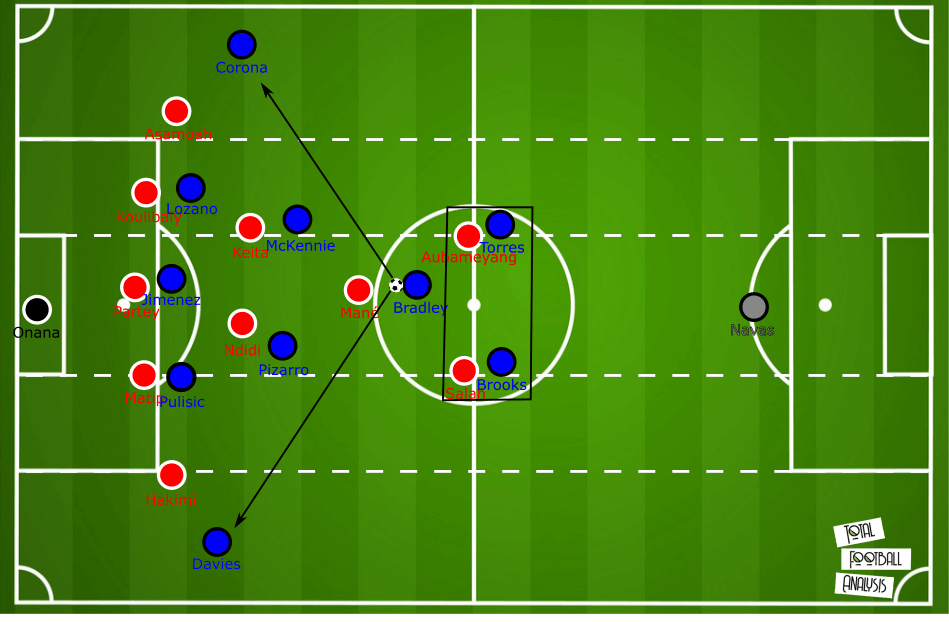
As we have two wing-backs in our midfield Asamoah and Hakimi can drop into a situational back five. Mane is intentionally positioned in a number ten role out of possession in order to give us a third man in midfield to pressure Bradley who is known to like to step into midfield to dictate the tempo of the game. As a result, we will emphasize having two of our attacking front three positioned as high as possible. Subsequently, if Bradley decides to step into midfield, he will be leaving his backline in a 2 vs 2 situation. When considering the threat of our attacking players, we will undoubtedly have a qualitative advantage if this unfolds. Once again we will remain compact centrally to prevent vertical passes being played through our defensive formation, see above.
Defensive transition – Exposing CONCACAF’s 2-3-5
As our analysis has shown, our formation means that CONCACAF adopts their 2-3-5 formation with a high amount of risk. Remaining compact centrally and forcing the ball into the wide-areas will allow us to maintain our defensive structure. We will look to win the ball on the flanks by having a central midfielder drift across to create a 2 vs 1 and prevent wing-backs from cutting inside. With two of our front three remaining high, upon winning the ball we will instantly have an attacking outlet to play to and exploit the vast spaces left by CONCACAF.

Below is an example once the ball has been won in a wide area. Our counter-attacks will be guided by two key principles, ‘forward first’ and ‘fill the lanes.’ The forward first principle will emphasize playing vertically once possession is won. Passes are played directly into the vacant space down the flank for either Keita to carry the ball forward or Aubameyang to run in behind. Filling the lanes will mean that as soon as the first pass is played, we will look to commit runners forward into each of the five channels on the pitch. This will force the opposition to spread themselves creating more space for us to run with the ball, or passing lanes to play into.
Conclusion
Talent is abundant throughout the African nations which made this an extremely hard choice when selecting this CAF lineup. Overall, I feel my team can lean on its qualitative superiority which affords flexibility in our system both in and out of possession which would be extremely hard for the CONCACAF team to contend with.





Comments